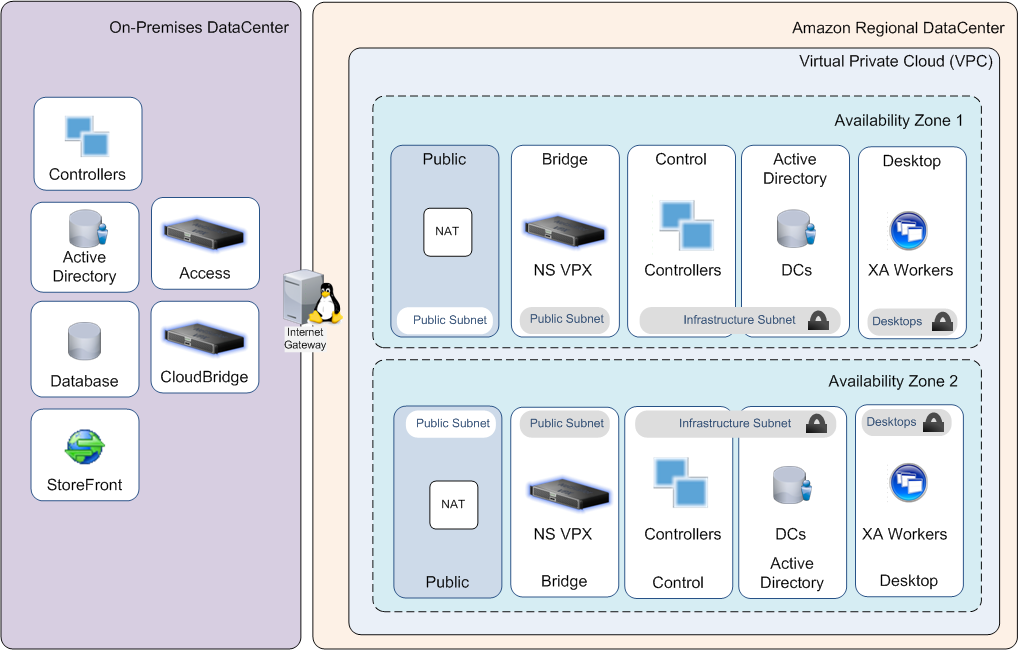Just as we have done in the past for XenApp 6.5, we are now able to announce the availability of the Reference Architecture (RA) for XenApp and XenDesktop 7.6. It took lots of late nights (or early mornings, depending on your perspective) with our friends over at AWS in Seattle and intercontinental teamwork, what with me being in Italy.
Yes, we have already already had–for over a year–a set of tools that allows you to spin up a XenApp or XenDesktop 7.5/7.6 Farm on AWS using CloudFormation technology. However, that CloudFormation template is aimed mainly at a Proof of Concept deployment of XenApp or XenDesktop on AWS.
We’ve silently updated these tools to a v2 version. This version supports XenApp and XenDesktop 7.5 or 7.6, as well as a choice of different firmware versions of the NetScaler Gateway being used. We also updated this POC type CloudFormation template to incorporate support for new EC2 instances like the m4 series and the t2.large.
For the v2 release of these tools, take a look here.
The RA for XenApp and XenDesktop 7.6 is just like the RA for XenApp 6.5 aimed at enterprises or service providers: (entities that have needs to incorporate or integrate with existing infrastructures).
We’ve focused on two common scenarios:
Common XenApp and XenDesktop 7 on AWS deployment scenarios
XenApp and XenDesktop can support a variety of application and hosted desktop delivery models. We’ve focused on two of the most common scenarios in relation to leveraging AWS: Hybrid Cloud XenApp and XenDesktop environment and a 100% XenApp and XenDesktop Cloud based deployment.
Hybrid Cloud XenApp and XenDesktop Scenario
In this scenario, a company wants to support its internal users within its enterprise by running XenApp or XenDesktop. The company extends its on-premises deployment to the cloud to increase capacity, improve performance, or scale the resource-intensive components in the cloud, when needed. This model also provides higher availability for business continuity and disaster recovery provided the user data is available during the event. Connectivity for this model relies on the NetScaler CloudBridge Connector functionality which creates a secure and optimized for XenApp and XenDesktop deployments VPN tunnel between the on-premises deployment and the AWS availability zones. See the figure below, which illustrates this scenario.
XenApp and XenDesktop Cloud Based Scenario
In this scenario, XenApp and XenDesktop are used by a service-oriented IT organization as the basis for desktop service delivery and cloud-ready applications as a service. All XenApp and XenDesktop services and user data are kept completely in the AWS cloud using multiple availability zones within one single AWS region. Corporate application data and user authentication could remain on-premises, or moved to a cloud delivery model as well. This model also relies on the NetScaler CloudBridge Connector functionality to create secure tunnels for corporate data with the AWS region and its availability zones, when needed. See the figure below which illustrates this scenario.
Key elements that distinguish this scenario from the previous Hybrid scenario are:
- Access and Web layer located in AWS cloud
- Active Directory domain controllers resident within the farm (not associated with the user environment)
I would advise that you spend some time with the XenApp and XenDesktop 7.6 Reference Architecture on AWS guide, which provides a lot of details to the steps that need to be taken to actually implement each of these scenarios.
Peter




